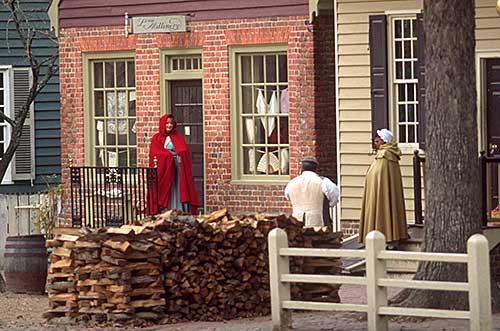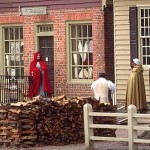The costumed interpreters at Colonial Williamsburg, who work 365 days a year, have unique challenges during extreme cold weather like today’s.
Imagine that you’re scheduled to be on Duke of Gloucester street for several hours as a character interpreter in single-digit temperatures. Your challenge is to stay warm with historically accurate clothing that reflects the high fashion of 1775 in keeping with your level of society.
“Keeping your feet warm is the biggest challenge for historic area interpreters,” said interpreter D. “Cash” Arehart, who’s also a production associate for educational media at Colonial Williamsburg. “They spend the bulk of their day standing on bricks outside or stones that take away all warmth from their feet.”
So the experts at Colonial Williamsburg’s Costume Design Center recommend standing on wooden surfaces whenever possible — but depending on the work assignment, it may not be possible.
Interpreters may be able to go in and out of buildings to get warm, but for many of the character interpreters, that’s also not possible. In extreme conditions, additional breaks or relief staff may be scheduled so that nobody is outside for any great length of time.
In the 18th century, soldiers on duty would likely be outside for an hour or more before they could come in for relief. At Valley Forge, soldiers who had to stand guard duty would be given the clothing from the soldiers inside the cabin so that they would have extra layers. The soldiers inside would shiver under thin clothing so that their comrades could survive by wearing multiple layers.
For today’s interpreters, modern conveniences including long underwear and warmers are allowed under costumes as long as they are completely hidden from sight, according to strict guidelines published by the Costume Design Center. Scarves, for example, are not documented in the 18th century.
And the higher up the social ladder that a person was, the fewer warm clothing options were available to them, due to fashion dictates. However, formal wigs were a good source of warmth for those who could afford them, “especially for keeping the ears warm,” said Arehart.
Ladies had additional challenges. A fashionable gown for the upper-class woman typically stopped just below the elbow. Interpreters today will wear a pair of woolen mitts in extreme cases, though they leave the fingers exposed. Extra petticoats and underskirts were often worn, along with cotton or woolen stockings.
But more concern was given to the fashion of the day and status than the practical need — a habit that sometimes persists in the 21st century.


At the Oliver Miller Homestead, a Whiskey Rebellion site in southwestern Pennsylvania, we have found that getting cool (in 18th century dress) can be even more challenging that staying warm. Our stone house is relatively cool as is the spring house, but being outdoors and in the wood structures in 90 some degree heat and humidity certainly makes many of our docents uncomfortable. How do you do it because I know your summers are much worse than ours?
I imagine that dressing properly to meet the weather’s conditions depended on what kind of clothing people had access to. For example, if people were poor did they knit their own socks, wear multiple pairs of pants, shirts, or dresses, layer up their under garments. But if people were wealthier they could probably afford fireplaces, buy more than one pair of stockings, shoes, clothing made out of wool.
How many people used wood burning stoves and how many of them suffered from carbon-monoxide poisoning, or how many of them lost their homes to fires?
The interpreters are to commended again and again for the wonderful and authentic presentation of 18th century life in all sorts of weather!
I have also read in clothing documents that it was not uncommon for women of all classes to stuff their petticoats with any number of materials: rags,straw,etc. It would seem that those petticoats would “talk when you walked!”
Just wondered why the temperature does not show anymore on the webcam? I always enjoy knowing the weather in CW!
The temperature is provided by an outside service. If the service is slow to respond, the page displays without it. Thanks for letting us know you are watching!